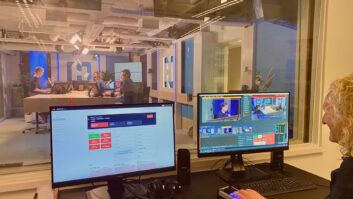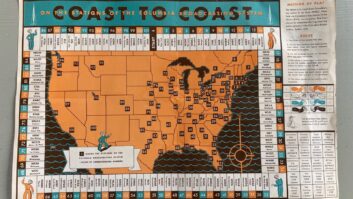
An electromagnetic binary-coded telegraph by Carl Gauss and Wilhelm Weber from 1833 is displayed at the Deutsches Museum.
MUNICH, Germany — The Deutsches Museum in Munich is one of the world’s largest technology and science museums, covering an area of more than 50,000 square meters and displaying some 28,000 exhibits from 50 fields of science and technology.
Founded on June 28, 1903, the museum attracts approximately 1.5 million visitors per year. The museum’s telecommunications section, which features an exhibition space of approximately 800 square meters, dates back to 1906. The telecommunications division was originally a subsection of the physics division, under the name “Telegraphy and Telephony,” but became a separate section in 1968.
FROM THE START
The museum covers the history of radio, from the first pioneering research of possible ways to send live messages to a destination out of a sender’s visual sight (mid 1800s) to the present digital age. The exposition presents the various objects with a logical connection between each item on exhibit, from past to present, illustrating a seamless evolution.
Modern radio broadcasting has its origins in the first studies regarding electromagnetism. In 1831 Michael Faraday demonstrated the mutual effects of electricity and magnetism, and put forward suggestions for a theoretical explanation. In 1833 professors Carl Gauss and Wilhelm Weber used an experimental set-up (originally designed for measurements of terrestrial magnetism) as an electromagnetic binary-coded telegraph.
The transmitter consists of an induction coil with a magnetic core. The reception is carried out by means of a long pivoted magnetized rod deflected by the electrical signals in the reception coil. The deflection was read off against the image of the scale reflected in a mirror, using a telescope. Gauss and Weber used this telegraph to communicate between their departments, at a distance of about one kilometer.
In 1863 school teacher Philipp Reis succeeded in transmitting individual notes by means of a device he called the telephone. In designing it, he used his knowledge of the human ear and how it perceives sounds.
TRANSMITTING SPEECH

Heinrich Hertz’s experiment, which took place in 1886, demonstrates the existence of radio waves and their polarity. As a transducer (i.e. microphone), he built a wooden box in which sound waves were focused by a funnel onto a membrane. Its vibrations created an electrical contact so that the circuit was completed, to a greater or lesser extent. In the receiver (earpiece), the changes in the currents caused a knitting needle to vibrate as a result of magnetostriction. The vibrations were made audible by means of a further wooden box, which served as a resonator. Speech was very indistinct, however.
In 1886 Heinrich Hertz successfully proved the existence of electromagnetic waves. The Deutsches Museum exposition allows the visitor to repeat Hertz’s groundbreaking experiment, combining it with the possibility to assess the polarity of radio waves. An instrument measures the amplitude of the received signals, which varies periodically according to the position of a rotating “grid” placed between the transmitting antenna and the receiving one.

In 1906 the first radio transmission of speech was performed using a sound-modulated arc transmitter. The microphone is fed directly into the antenna circuit. Tests with spark gap transmitters started in 1894, and allowed for the possibility of the wireless transmission of telegraphy signals. Guglielmo Marconi’s transmissions were based on a spark-gap transmitter, unable to produce continuous waves and then to perform voice transmission. Arc transmitters, invented in 1903 by Valdemar Poulsen, generated continuous waves, thus posing the basis for voice transmission.
Radio transmitted speech for the first time in 1906, over a distance of 40 kilometers (from Berlin to Nauen) using an experimental sound-modulated arc transmitter. The microphone was fed directly into the antenna circuit. This method was soon abandoned because there was no way to amplify the sound at that time.
In 1911 Otto von Bronk developed a circuit arrangement with a vacuum tube, which made amplification of high-frequency radio signals possible. The development of thermoionic tubes during World War I provided the basis for radio broadcasting, which started in 1920 in the United States and in 1923 in Germany.
MODERN DAY

A Philips water-cooled transmitter tube from 1924 with a 300 kW Telefunken water-cooled tube (right). The name Telefunken itself is a tribute to spark-gap transmitters: “funken” in German means “sparks.” The Philips water-cooled transmitter tube from 1924, and a Telefunken water-cooled tube with a transmission power of 300 kW on show at the museum testify to the early years. By the late 1920s, long-wave, medium-wave and shortwave ranges were available; ultra-shortwave (FM) radio, which made stereo transmission possible was introduced after World War II. Simultaneously, storage methods were improved, particularly with the invention of the sound-recording tape in 1928.
After the end of World War II, radio broadcasts became a part of private and public life, and military research into radar systems played a considerable part in this development.

A radio frequency direction finder based on the Watson-Watt principle, showing a glowing-red mark, which indicates the active transmitter and its location with respect to the listening point.
Robert Watson-Watt developed a radio frequency direction finder to determine the direction of the incidence of electromagnetic waves. This device scans the electromagnetic field using a crossed-loop antenna (two loop antennas mounted at 90 degrees), amplifies it and displays its component. These appear on the oscilloscope as an ellipse whose axes represent two opposite directions. The additional information from an auxiliary antenna allows the suppression of the “wrong” half of the ellipse.
Soon after the conclusion of the World War II, the transistor was invented and high-frequency signals were first used for broadcasting, paving the way for modern radio broadcasting.
Davide Moro reports on the industry for Radio World from Bergamo, Italy.










